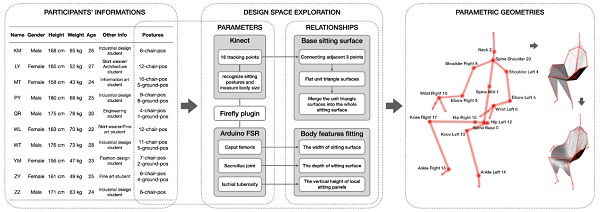Parametric Industrial Products
PARAMETRIC DESIGN FOR INDUSTRIAL PRODUCTS
Shaoting Zeng1, Song Qiu1
1Tsinghua University

Figure 1. Experiment participants’ information and design space exploration process.
The main contents of this paper are the parametric design and its applications in industrial design, taking the ergonomic chair as the main design research carrier, conducting the experimental study, and explored the parametric industrial product design procedures and methods based on personalized design notion of “Form follows behaviors”.
The research map focused on two fundamental parts of parametric design definition: the construction of the parameter relationship and the acquisition of parameters. The first part, through design space exploration (DSE), to translate the design problem into parameters relationship and variable ranges.
The second part, using various software and hardware tools (Grasshopper, Arduino with pressure sensors, Kinect, etc.) to facilitate parameter acquisition and its application in the 10-person customer-driven experiments to the resulting design models and user datasets. Finally, through the formulation of quantitative evaluation for 110 sets of user data and models, selecting the best design solution for the 3D printed prototype, and conducting the user test.

Figure 2. The wearable sensors devices and the experimental space.
Parametric design and digital technologies have been becoming increasingly essential for industrial design in recent years (Connors et al. 2019). The progress of sensors and smart hardware also enables more ergonomics and anthropometry to permeate into design studies (Baek and Lee, 2012).
We take the ergonomic chair as the research carrier, conducting 10-person customer-driven design experiments with multi-sensors, exploring the construction of the parameter relationship in algorithmic industrial product design.

Figure 3. The visualization of all 110 personal data.
There have been various design studies on ergonomic seats based on parametric platforms and different sensory devices. Digital artist Zhoujie Zhang equipped the Sensor Chair with a tactile-sensitive sensor system and visualizing the self-generating chair designs as they were in the formation via user interaction (Zhang and Yan, 2020).
Li et al. (2020) installed pressure and ultrasonic sensors with Arduino on a seat for sitting posture correction based on ergonomics. In addition to sensors fixed on chairs, wearable devices with sensors have been widely used in ergonomic design (Salvado, 2016).
In our study, we adopted the wearable pressure sensing device that can provide participants more choices, such as shifting chairs and sitting positions by favor, or even sitting on the ground, in order to generate more innovative seat shapes from their natural postures.

Figure 4. 4 quartiles lists typical seat shapes.
The Microsoft Kinect has been applied in ergonomic design researches. ActiveErgo system used the Kinect sensor for monitoring to determine the ideal personalized furniture positions for different users (Wu,2018). The Kinect v2 has standing and sitting modes, which can accurately measure the sitting posture details of participants for our experiment.

Figure 5. The formation process of KM03 chair.
The statistical and mathematical methods for ergonomic evaluation are also significant for the study (Burkov, 2019). We formulated a criterion of ergonomics evaluation for the 110 sets of personal data we detected during the experiments and selected the optimal seat surface shape for the 3D printed prototype.

Figure 6. The pictures of 3D printed chair and users test.
After getting the ranking list of all the data and the quartiles lists, we conducted the qualitative and quantitative analysis. Firstly, we wanted to confirm whether the top 7 ranking list is the best options for the design, and secondly, we also wanted to know what are the characteristics of the 4 quartiles lists and whether the sitting postures and seat shape corresponding to each list have any commonalities or regularities?
We imported the video screenshots of each set of data recorded during the experiment into Adobe Animate according to the sequence of evaluation results and adjusted the frame rate to 1 second per frame to produce video animation in SWF format.
By repeatedly watching the animation to search patterns and characteristics of each list, we found that each list has its own typical seat shape and sitting postures, which appeared more times saliently than other types, as shown in Figure 4.

Figure 7. The 5 generative female-specific seat shapes.
First, the typical seat surfaces of list 1 look like “Patrick Star”, they have clear limb shapes and a straight belly. The characteristics of corresponding sitting postures are that the limbs are extended relative to each other, and the femur presents a downward sloping angle to the seat surface, the participants‘ hip usually sit in the front of the seat, with the back leaning against the chair back.
At this time, participants’ pelvis tilted forward, which is healthy to the human body’s spine and similar to the sitting position of the saddle chair (Wallace,2010).




























Comments